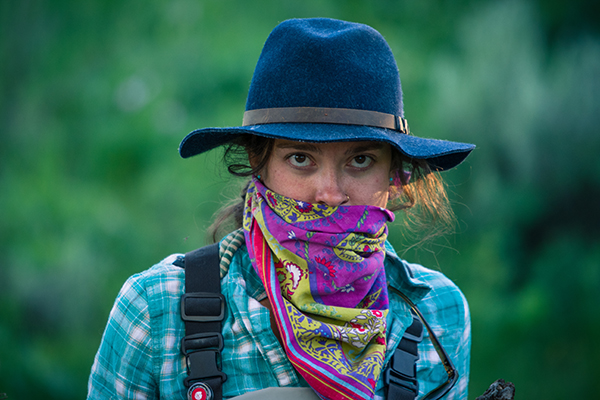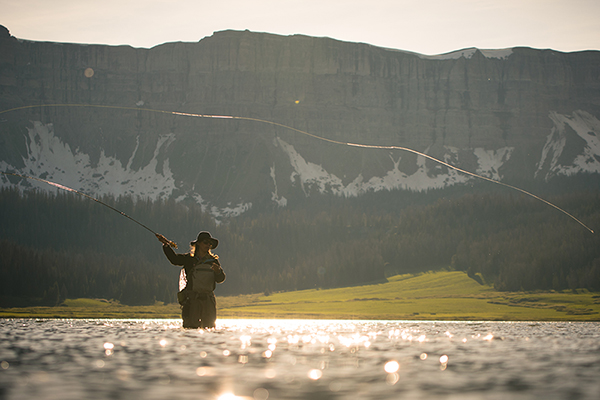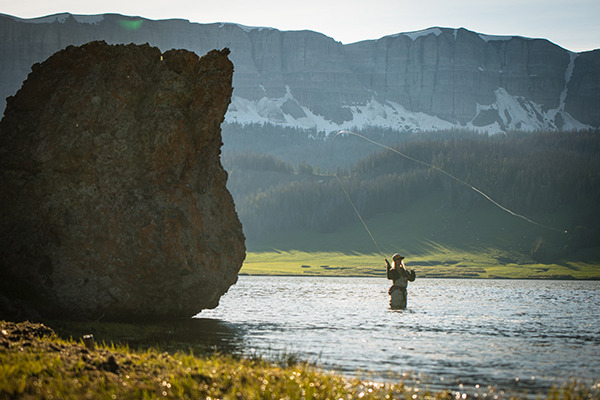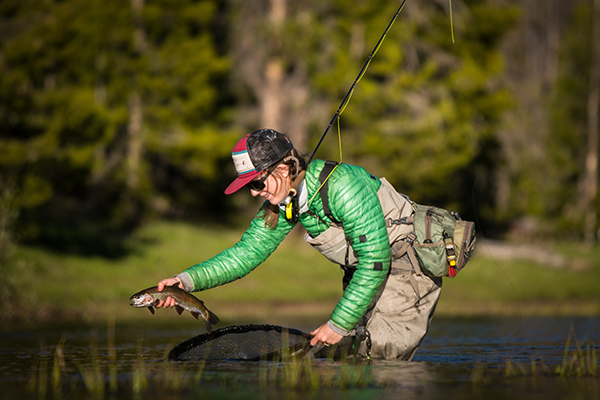Fly Fishing in Wyoming with the Tamron 70-200mm
Growing up in Colorado, and now a grad student at the University of Wyoming, Ben Kraushaar has spent his entire life immersed in the great outdoors. He’d always been interested in taking pictures while enjoying Mother Nature, but it wasn’t until 2012 when this casual hobby captured more of his attention.
“I’d decided to hike the Colorado Trail, a nearly 500-mile backpacking trip that starts in Denver and ends in Durango,” he says. “I wanted to document the journey, so I finally invested in a relatively decent camera. My goal was to fly-fish the whole trail and take photos the entire time. After that trip, I published an article about my experience in a fly-fishing magazine, and that was the catalyst for all of my future adventures.”
This summer Ben indulged both passions in Wyoming, where his girlfriend, Anna, was conducting fieldwork. To capture photos on this fly-fishing trip, he used the new Tamron SP 70-200mm VC G2 lens, which he says was invaluable for its focal-length range and Vibration Compensation (VC) technology. “With the 5-stop image stabilization on this lens, it made shooting handheld much easier—and I primarily shoot handheld when I’m fly-fishing,” he says. “It’s too much to haul a tripod into the backcountry. The VC proved especially helpful, as I generally have to use a really fast shutter speed to slow the bend of the rod down to freeze it. The best fly-fishing photos are also generally in lower light, so having that VC allows me to use that faster shutter speed in those lighting conditions to freeze the scene.”
Telling the story of a full day of fly-fishing means paying attention to every aspect of the sport. “It’s more of a lifestyle than an individual event, so there are plenty of things associated with it that can serve as subjects,” Ben notes. “Whether it’s photos of people camping, getting ready to fish, or the actual act of fishing, there’s plenty of versatility in terms of the tale you can tell. You also can’t neglect those amazing landscapes in front of your camera, or the close-up shots of the fish if you’re lucky enough to catch one.”
Ben typically heads out in the late afternoon or early evening for his fly-fishing adventures. “The best fishing is during those times, and that coincides with the best light,” he says. “I don’t mind shooting in midday if it’s overcast, but when it’s sunny, it’s hard to reduce all of the shadows. I shoot all natural light, mainly because carrying extra lighting equipment would be difficult. Since I’m also fly-fishing, I usually have my rod and other fishing gear, so I try to keep my photography equipment to a bare minimum.”
The 70-200 G2’s maximum F/2.8 aperture helps Ben set the scene as he wades, often knee-deep, into the water. “When I’m shooting a photo of someone casting a line, I try to use a low aperture like that F/2.8, especially when there’s a busy background,” he says. “Whether it’s trees or bushes, that low aperture helps blur out the background and isolate my subject. It also eliminates noise when I’m trying to get a silhouette of my subject against a blue sky or the water.”
Ben’s biggest challenges when fly-fishing? Besides that less-than-ideal lighting during midday fishing expeditions, it would be the natural perils that come with the sport. “Sometimes the rivers are really slippery,” he says. “I have to do my best to try not to fall in and ruin my equipment.”
Which leads to the important matter of Ben keeping his gear protected. “I’ve yet to drop my camera in the water, but I have dropped five phones,” he laughs. “Sometimes I can tuck my camera in my waders a bit, so when I’m walking and splashing in the water, it’s not getting very wet, but the moisture-resistant build on this lens helps immensely on dreary, drizzly days. Sometimes my favorite photos come from when I’m out in the rain or snow, so having that water resistance is clutch and gives me the confidence that I’m not damaging my gear.”
Here, six of Ben’s images from his trip to the Cowboy State:

200mm, F/2.8, 1/400th sec., ISO 400
This is a photo of my girlfriend, Anna. She’s a wildlife biologist. She always likes wearing colorful bandannas to keep the sun off her face and neck, and she’s shooting me a little glare here because I’m taking her picture. What’s nice about the 70-200 G2 is its capabilities as a portrait lens. With that F/2.8 aperture, you can achieve appealing bokeh and create some beautiful portraits.

190mm, F/2.8, 1/400th sec., ISO 400
This photo of Anna catching a trout was taken on a river near Pinedale. It was evening, so the gold reflection on the water is from that last golden light in the sky. The river was mostly in the shadows, but the sun was really low, so I was able to capture all of those yellow-orange tones.
I was standing up on a hillside for this shot. At that higher perspective, I was able to get nothing but water next to her in the frame. If I’d been positioned lower, I would’ve gotten the bank on the other side of the river, which would’ve taken away from the photo. I was at 190mm, so I was zoomed almost all the way in.

200mm, F/2.8, 1/1600th sec., ISO 100

70mm, F/2.8, 1/3200th sec., ISO 100
These next two photos show Anna casting a line, which means I had to try to freeze the action, as I discussed earlier. Usually, the line and the tip of the rod are moving really fast, so to freeze that and not get any blur of the line or rod, you have to shoot really fast. I usually end up shooting 1/1000th or faster for fly-fishing. Having that F/2.8 maximum aperture at 200mm allows me to get really tight and isolate my subject.

116mm, F/2.8, 1/640th sec., ISO 100
When you’re out on the river, there are an endless number of potential objects to shoot through and use as frames for your subjects. It’s really fun to play around with. In this case I blurred the greenery in the foreground a bit, which made an effective frame for Anna as she was wading away from me.
I also like the composition of this image (the whole walking-away narrative), because with fly-fishing, there’s a mysterious aspect to it. People will often post a picture of themselves fishing somewhere, and they won’t want to give their location away because it’s a sweet spot. So having just a hat in the photo, or someone looking away, adds to the whole secretive nature of the sport.

70mm, F/2.8, 1/2000th sec., ISO 100
We were at a lake near Dubois, Wyoming, and we came upon this scene with this one huge, random boulder. If you look around the rest of this area, it’s pretty clear of any sort of rocks, yet here we had this one beast. I wanted to take a landscape shot, but by putting a person into it, I was able to create a sense of scale. With this lens, you can zoom out to get a wider view or get the subject tighter in the scene by pulling the background in closer.

200mm, F/2.8, 1/2000th sec., ISO 100
This is a photo of one of my girlfriend’s collaborators on her research project; she’s also really into fly-fishing. Here’s where she’s holding up the ultimate prize—a fish she caught. Sometimes you can spend over an hour trying to figure out what fly to tie on or what the fish are eating, so when you finally do catch a fish, it’s a very rewarding experience that proves you solved some sort of puzzle.
When that happens, the atmosphere changes from super-quiet peacefulness to animated excitement. I wanted to document that energy, and the emotions she was showing through her facial expressions, when she got to finally hold the results of all her hard efforts. By zooming in to 200mm, I was able to capture that moment.
To see more of Ben Kraushaar’s work, go to www.benjaminkraushaar.com.